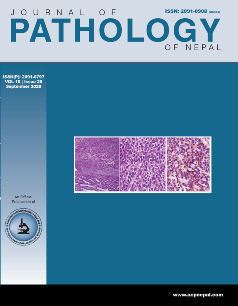Immunophenotyping in incidental gastrointestinal neuroendocrine tumors: study at tertiary care centre
DOI:
https://doi.org/10.3126/jpn.v10i2.29754Keywords:
Chromogranin; Incidental; Ki67 index; Neuroendocrine; SynaptophysinAbstract
Background: Gastrointestinal neuroendocrine tumors are rare slow-growing tumors with distinct histological, biological, and clinical characteristics that have increased in incidence and prevalence in the last few decades. This study is aimed to find out the incidence of neuroendocrine tumors among the gastrointestinal tumors and to grade gastrointestinal neuroendocrine tumors.
Materials and Methods: A total of 119 cases of gastrointestinal tumors of gastrointestinal neuroendocrine was included in the study. The paraffin blocks were retrieved and slides were stained with routine Hematoxylin and Eosin, synaptophysin, chromogranin, and Ki67. The histologic grading was done based on mitosis and Ki-67 index as per WHO 2017 classification.
Results: Out of 119 cases of Gastrointestinal Tract tumor, 13 (10.92%) constituted neuroendocrine tumors. Duodenum was the most common site (38%) followed by the appendix (23%). The majority (1.9%) of the cases were categorized as of grade 1 followed by 2.3% of grade 2 and 1.19% of grade 3. Immunohistochemically, chromogranin, and synaptophysin were strongly expressed in all ten cases of neuroendocrine tumors. The Ki67 labeling index was <3 % in 10 cases, while it was in the range of 3 – 20 % in 2 cases and >20 % in one case.
Conclusions: The incidence of gastrointestinal neuroendocrine tumors is on the rise. They should be considered in developing a differential diagnosis. Hence use of diagnostic modalities such as immunohistochemistry should be implemented for better treatment.
Downloads
Downloads
Published
How to Cite
Issue
Section
License
This license enables reusers to distribute, remix, adapt, and build upon the material in any medium or format, so long as attribution is given to the creator. The license allows for commercial use.




